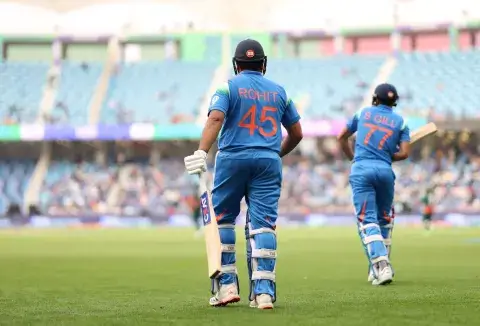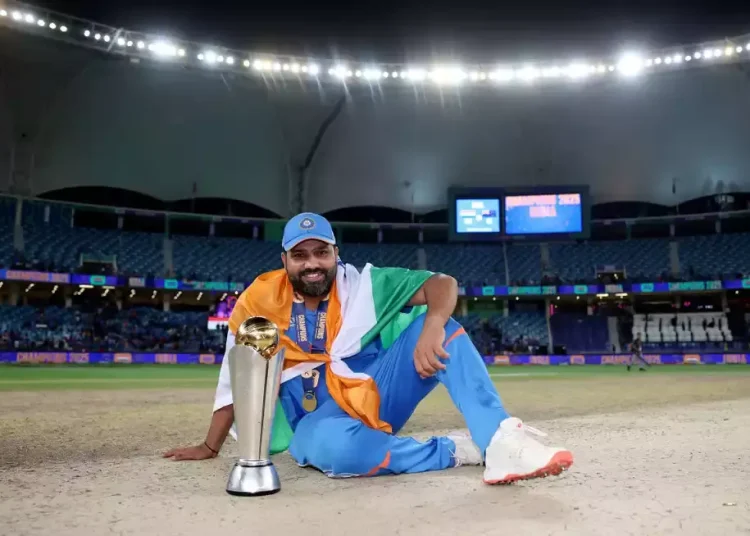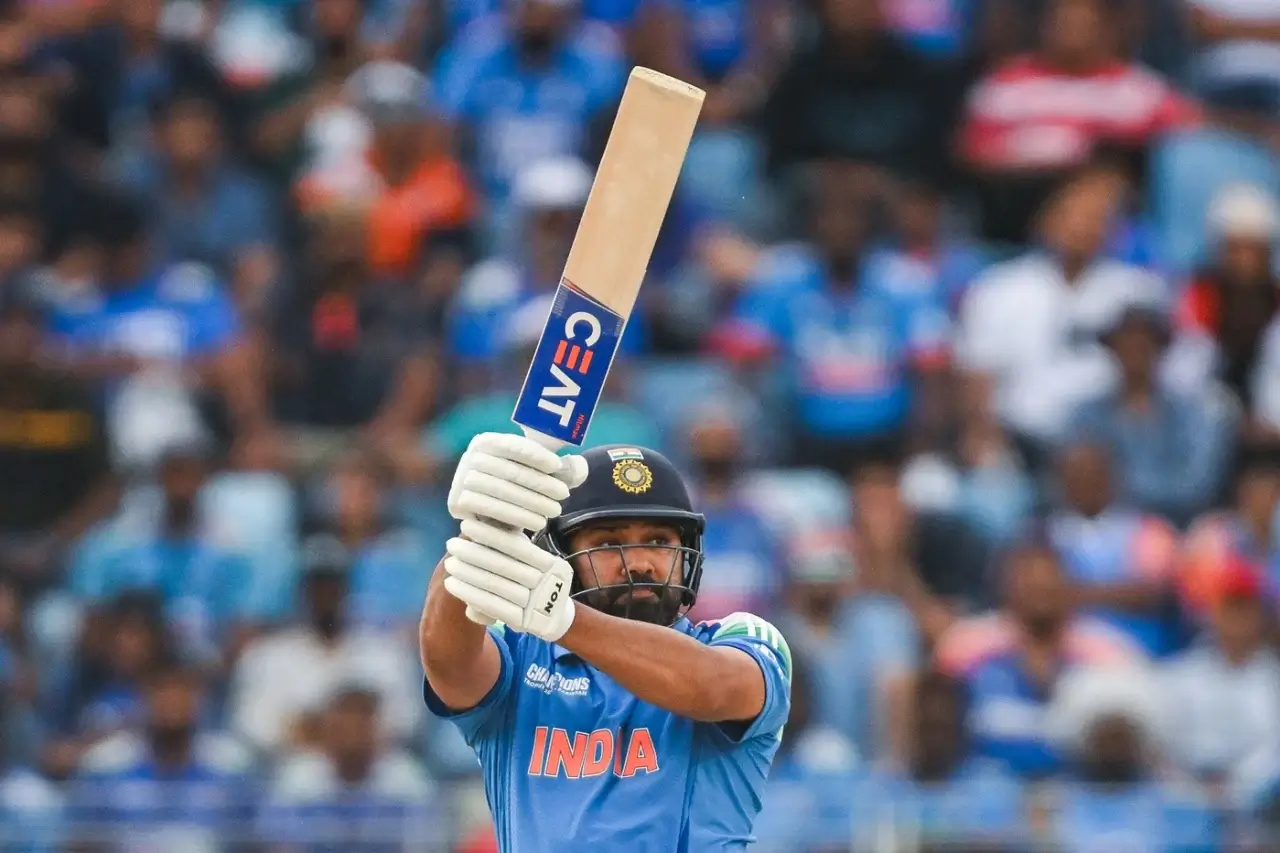At thirty-eight, Rohit Sharma shouldn’t be playing like this, but he is. Under the glowing lights of Sydney, the Indian opener rolled back time with a flawless 121 not out against Australia. It was his 33rd ODI century, yet it carried the freshness of a debut hundred. Every shot was measured, and every run felt like a statement to his critics.
This wasn’t just another knock; it was a quiet declaration that Rohit Sharma remains the heartbeat of Indian batting. Over the past five years, his role changed, his tempo evolved, and his hundreds became rare. Yet the skill, composure, and trademark acceleration were never gone — only hidden beneath the demands of captaincy and balance, like Australian matches.
The Sydney innings brought all those traits back. Rohit’s footwork was clean, his intent was sharp, and his reading of conditions was immaculate. Facing Mitchell Starc and Josh Hazlewood, he bided his time before finding rhythm. He wasn’t chasing headlines — he was chasing peace, rhythm, and timing. By the time he reached his hundred, the only emotion visible was calm satisfaction.
For fans and selectors alike, this knock was a gentle reminder. Rohit Sharma is still very much around, and writing him off might be the biggest mistake India can make ahead of another World Cup cycle.
Sydney Night and the Return of the Classic Rohit
 In an age of instant cricket, patience has become a lost art. But Rohit Sharma’s Sydney innings brought it back in style.
In an age of instant cricket, patience has become a lost art. But Rohit Sharma’s Sydney innings brought it back in style.
Against a disciplined Australian attack on a responsive SCG pitch, he rebuilt his innings brick by brick. The early overs were a study in control — soft hands, compact footwork, and intelligent strike rotation. Once the ball softened, Rohit began expanding his range, cutting, pulling, and driving with the grace that defined his prime years.
This knock resembled his old template from 2013 to 2019, the golden period when Rohit mastered the art of constructing long ODI innings. His method remains simple — respect the new ball, build through the middle overs, and explode late.
In Sydney, the chase didn’t require a big finish, yet his approach remained textbook. The accumulation phase was steady, the shot selection precise, and the confidence unmistakable.
What impressed most was how he controlled tempo without losing fluency. Against Zampa, he didn’t take risks; he milked singles, waiting for mistakes. His composure under pressure highlighted what younger players can still learn — how to dominate by being calm. It was vintage Rohit, the man who doesn’t need to shout to make a statement.
A Journey Through Form, Role, and Reinvention
Rohit’s last five years have been a rollercoaster of roles and adjustments. Since taking over India’s leadership mantle, his batting identity has evolved from a run-machine to a hyper-attacking initiator. The plan was simple — take pressure off the middle order by attacking early. That approach reduced his centuries but raised his influence as a modern ODI opener.
However, as this series showed, the old rhythm isn’t gone. In Perth, he tried to dominate and fell early. In Adelaide, he adjusted and scored a gritty 73 under tough conditions. By Sydney, the refinement was complete — calm, calculated, and confident. He understood the surface, respected the conditions, and maximized opportunity.
In his post-match chat with Adam Gilchrist and Ravi Shastri, Rohit reflected on “a lot of good memories and bad ones” in Australia. Earlier this year, the same ground had witnessed his heartbreak — being dropped from India’s Test side after a poor run. But cricket, like life, offers comebacks when you least expect them. Rohit’s hundred wasn’t revenge; it was redemption — gentle, composed, and personal.
Reinvention Through Experience
Many forget that Rohit’s batting transformation didn’t come by accident. It’s been built through constant analysis, self-awareness, and clarity. He has always known his strengths — timing, placement, and reading the bowler early. Even at thirty-eight, he doesn’t rely on brute force; he relies on rhythm. The Sydney innings proved that great players don’t fade — they evolve. Rohit has found a sustainable model for longevity, balancing aggression with endurance.
Numbers That Prove the Point
Since 2020, Rohit has scored fewer hundreds, but his overall contribution remains elite. His average of 47.65 and strike rate above 111 make him one of the most efficient openers of the era. Only Travis Head has matched that level of productivity among contemporary openers. Even with fewer centuries, Rohit’s influence on India’s ODI structure is profound — he sets tempo, absorbs pressure, and builds partnerships.
His 33rd century now puts him behind only Tendulkar and Kohli among Indians. He has shown remarkable consistency in big matches, especially in Australian conditions. This hundred marked his fifth century on Australian soil, yet it was the first in a winning cause. That’s what made it more meaningful — a career coming full circle at the venue that once defined his struggles.
For a player nearing forty, Rohit’s physical conditioning and shot precision remain outstanding. His ability to bat deep and still find timing late in innings makes him unique in an era of quick bursts. Sydney reminded everyone that this isn’t a farewell tour — it’s a continuation of class refined by time.
Future Outlook — The Road Ahead
With T20Is now behind him, Rohit’s ODI journey enters its final phase. The next big stop is the 2027 World Cup in South Africa, when he will be forty. While many might question his longevity, the Sydney performance answers that doubt convincingly. His batting rhythm remains intact, his motivation high, and his hunger visible.
Selectors and team management must now focus on continuity. Rohit doesn’t need to play every series, but he needs rhythm. A balanced schedule — frequent enough to keep him sharp yet manageable to avoid burnout — is key. His value goes beyond runs; it’s about experience guiding India’s next generation of openers. Youngsters like Gill and Rawal will benefit immensely by sharing space with a master still writing his own chapter.
India’s future planning shouldn’t replace Rohit; it should revolve around him for one last cycle. Because when the next World Cup begins, you’ll still want Rohit Sharma walking out first — calm, composed, and ready.
A Reminder for the Selectors
If the management wanted a signal about Rohit’s readiness, Sydney delivered it. He’s still among the best at pacing ODI chases, reading conditions, and holding partnerships together. Even if his strike rate slows occasionally, his match sense compensates for everything. You don’t retire balance — and Rohit remains India’s balance at the top.
Legacy and Lessons for Indian Cricket
Rohit Sharma’s century wasn’t just a personal achievement; it was a lesson for Indian cricket. It showed that adaptability and timing are still worth more than raw aggression. It underlined why experience matters in a side full of youth. For the younger batters, this was a tutorial in control — how to build, sustain, and finish innings under varying conditions.
Beyond the numbers, the innings represented the spirit of Indian cricket — patient, smart, and quietly dominant. It was also poetic that Rohit’s comeback century came on the same ground where his Test captaincy ended. That moment of reflection turned into one of redemption, the kind that doesn’t need loud headlines.
This match will sit high among his best — not because of the runs, but because of the message it carried. Rohit Sharma isn’t playing for milestones anymore. He’s playing for joy, rhythm, and that perfect feeling of timing a drive through extra cover.
Conclusion
Rohit Sharma’s Sydney hundred was more than a century; it was a conversation with time. He reminded the world that form may fade, but class doesn’t retire. The innings had everything that defines him — balance, grace, patience, and an understanding of rhythm that few players possess today. For Indian fans, it was comforting to see the old Rohit again, not desperate, not pressured, just himself.
He will take a short break before his next series, and that’s a good thing. At this stage, his body needs management, not restlessness. If India uses him smartly, he could still lead the batting core into another World Cup cycle. Sydney wasn’t an ending — it was a statement that the story still has chapters left. For now, he’s proven that no matter what age says, Rohit Sharma can never be written off.





